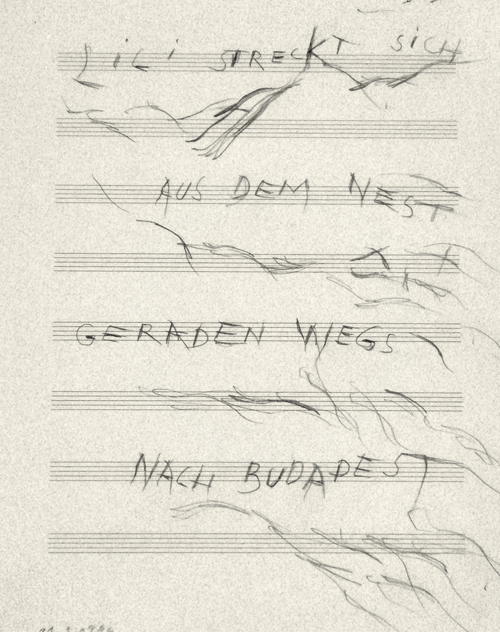Wiener Gruppe II: Gerhard Rühm
An interview with Gerhard Rühm
An interview with Gerhard Rühm

PABLO LARIOS How closely linked are the sound poems and ‘typo-collages’ in your work? Did one progress from the other, or did you pursue these simultaneously?
GERHARD RÜHM Fundamentally speaking, I tend to distinguish between visual and aural poetry. Sound poems, by their very nature, have to do with the human voice, and thus require acoustic reproduction. I wrote my first sound poems in 1952, stimulated on the one hand by the expressive, extremely concise short music pieces of Anton Webern, on the other by the prevailing Informel painting movement. Sound can also be visualized through script, just as how one can interpret smaller and bigger letters as stronger and weaker tones. Their arrangement on a surface, and the suspension of linear notation, gives way to further possible differentiation. In the mid 1950s I was producing images using letters, as well as visual word constellations. My text works were first shown in Gallery Würthle, Vienna, in 1958. In the ’60s, with the technical possibilities of the broadcasting studio, I further developed spoken sound poems, some of which were released on record. To this day I have continued to make auditory as well as visual sound poems.
PL You once suggested that transnationality is an important aspect in the Concrete movements, including poetry. Yet for your visual collages, as well as your concrete poetry, you frequently use local and regional elements – Viennese dialect, for example, or Austrian and German newspapers. How would you describe the relationship between these two impulses in your work? Are they in conflict with one another?
GR Even though ‘concrete poetry’ was a special concern of mine, particularly in the ’50s and ’60s but also still to this day, language has always interested me in all its forms and possibilities of expression. Hence the breadth and variety of my output. Everything is interconnected: auditory poetry has musical parameters with all sorts of points of transit to music, and visual poetry has completely pictorial aspects – from handwriting to design. Consequently, sound poetry in particular, compared to semantic literature, has the advantage that it does not need translation – it has a way of communicating directly, similar to music. The individual sounds of speech have characteristic, internationally intelligible qualities of expression.

PL Did visual concerns play a central role for the Wiener Gruppe?
GR For H. C. Artmann and Konrad Bayer poetry’s visual aspects played a subordinate role. For Oswald Wiener these visual aspects were intermittently relevant. For Friedrich Achleitner and me, on the other hand, visuals have always had a special significance. Particularly since my own work cannot be imagined without the visual and the auditory aspects of poetry.
PL There were several connecting points between the Wiener Gruppe and the Actionists.
GR We had friendly relations to the Viennese Actionists, who formed somewhat later, in the ’60s. They were based on related objectives that occasionally led to collaborations and joint events.

PL You are also a classically trained musican. Did your musical influences include avant-garde movements such as the twelve-tone technique, or Austrian composers such as Hanns Jelinek? And were you also influenced by subsequent movements, such as Jazz and Pop music?
GR The tradition of twelve-tone music in Vienna was barely alive save for a few Schönberg students, who survived the Nazi regime by ‘inner emigration’. One could inform oneself privately though only in broad strokes. Josef Matthias Hauer continued to live in Vienna, reclusively until 1959. He taught me his deeply personal version of the twelve-tone technique. Only a few – those of us who were hungry for knowledge – were interested in such things. At the time, in Austria, we were thought of as devious, and were actively suppressed by the state. I got to know Hans Jelinek personally and remember him as a pleasant and approachable person. His twelve-tone compositions, however, did not entirely convince me.
Excitement about jazz was widespread among our circles. At the Vienna Academy of Music, where I studied at that time, jazz was not welcome, and even officially forbidden. But thanks to the American Information Center, where one could take out jazz records, we were soon in the know about the most important jazz movements and figures.
PL How well known were movements such as Dada and Surrealism, or figures like Hugo Ball or Kurt Schwitters, and how accessible were their works?
GR After World War II, we had to arduously rediscover the classics of modernism, which had been persecuted and ostracized during the barbaric Nazi dictatorship. Finding something pertinent in a second-hand shop was a godsend. New editions of expressionist or surrealist literature, if they were even available, were often only selectively published within anthologies and often came into our hands late. In libraries works of this type were barely to be found.
Translated by Yael Salomonowitz
Gerhard Rühm is an Austrian writer and artist and a founding member of the Wiener Gruppe.
















